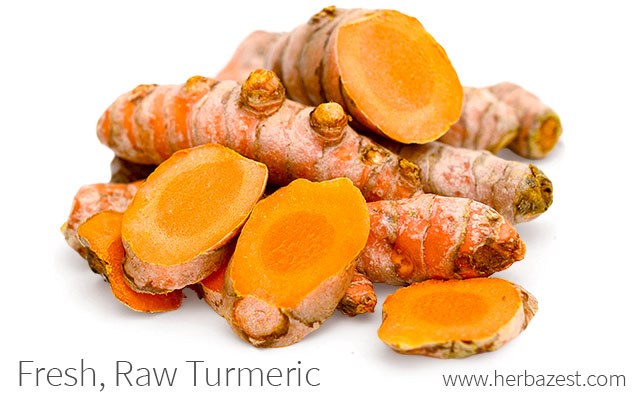Fresh turmeric refers to the raw, untreated rhizome of the turmeric plant. Mainly available at a number of Asian markets and ethnic grocery stores, it is a rigid, light brown rootstock with a rich, deep orange flesh.
How to Consume Fresh, Raw Turmeric
Raw turmeric must first be peeled and then sliced, minced, ground, or julienned before use. The following preparations can be used to enhance nutrition and obtain turmeric's antioxidant and anti-inflammatory healing properties:
Turmeric drinks. Fresh turmeric has a light, citrusy taste that is sure to enhance many beverages. For a delicious new way of obtaining its many health benefits, try blending raw turmeric into smoothies, juicing it with fruits, or steeping it in a warm cup of turmeric tea.
Fresh turmeric extract. Turmeric extract holds many natural properties. To fully benefit from its anti-inflammatory, antimicrobial, and antioxidant actions, take fresh turmeric extract, three times a day according to the label instructions.
Turmeric with food. Whole turmeric pieces are often minced or otherwise broken down before being added to various sides and entrees. In traditional Indian cuisine, fresh turmeric is used not only for curry, but also for a number of different soups, stews, and rice dishes. To further potentiate its medicinal action and rate of absorption, it is recommended to prepare fresh turmeric with a bit of black pepper.
Benefits of Consuming Fresh Turmeric
Besides flavoring food and serving as a coloring agent, raw, fresh turmeric also acts as a natural preservative, lasting for up to two weeks in the fridge. It provides the same health benefits as other forms of turmeric, except with a subtler flavor and a greater availability of nutrients, such as calcium, magnesium, phosphorus, and potassium. It also provides some dietary fiber, which aids in digestion.
Fresh turmeric contains high levels of curcumin, a naturally-occurring pigment responsible for the majority of turmeric's health benefits. Curcumin and other curcuminoids work together to reduce inflammation by lowering histamine levels and blocking chemical compounds that cause inflammation.1 It also protects against cellular damage caused by free radicals in the body, and is, therefore, believed to be an important medicinal herb for the prevention of Alzheimer's, dementia, and other neurodegenerative illnesses.2
The benefits of fresh turmeric for liver health are achieved by stimulating bile flow and excretion for an overall choleretic effect.3,4 It is also an antidiabetic, stabilizing glucose levels in the blood.5
Because of the above-mentioned health benefits, raw turmeric has been the subject of intense scientific debate. Researchers have, in recent years, sought to evaluate its therapeutic properties and potential side effects in order to determine the extent of its efficacy for arthritis and other conditions.
When consumed in the recommended doses - up to 1,500 mg daily - as part of a well-balanced diet, raw turmeric provides the same health benefits as its dried counterpart. Though not as convenient as the powdered spice, fresh turmeric can still be incorporated into a number of healthful home preparations, and it has the potential to be a beneficial component of any natural healthcare regimen.
Sources
- Chemical and Pharmaceutical Bulletin, Natural antioxidants. III. Antioxidative components isolated from rhizome of Curcuma longa L., 1985
- International Research Journal of Pharmacy, Comparative studies on curcumin content in fresh and stored samples of turmeric rhizomes, 2011
- The illustrated cook's book of ingredients, p. 344
- Turmeric: The wonder spice
- Journal of Food Science, Choleretic activity of turmeric and its active ingredients, 2016
Footnotes:
- Journal of Clinical & Diagnostic Research. (2014). Evaluation of Efficacy of Curcumin as an Add-on therapy in Patients of Bronchial Asthma. Retrieved October 6, 2021, from: https://www.ncbi.nlm.nih.gov/pmc/articles/PMC4190737/
- Ayu. (2012). Effects of turmeric on Alzheimer's disease with behavioral and psychological symptoms of dementia. Retrieved October 6, 2021, from: https://www.ncbi.nlm.nih.gov/pmc/articles/PMC3665200/
- Gut. (2014). Turmeric curcumin inhibits entry of all hepatitis C virus genotypes into human liver cells. Retrieved October 6, 2021, from: https://pubmed.ncbi.nlm.nih.gov/23903236/
- Archives of Medical Science. (2019). The role of curcumin in liver diseases. Retrieved October 6, 2021, from: https://www.ncbi.nlm.nih.gov/pmc/articles/PMC6855174/
- Avicena Journal of Phytomedicine. (2016). The effect of nano-curcumin on HbA1c, fasting blood glucose, and lipid profile in diabetic subjects: a randomized clinical trial. Retrieved October 6, 2021, from: https://www.ncbi.nlm.nih.gov/pmc/articles/PMC5052420/




